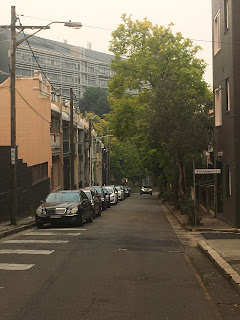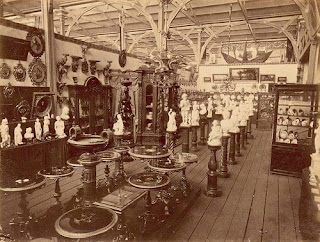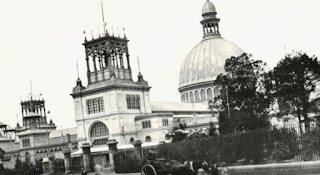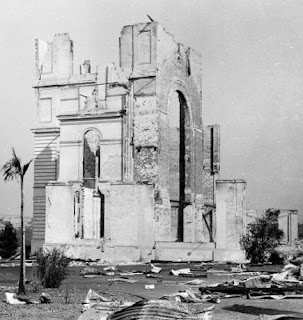Search This Blog
Saturday, April 24, 2021
First Sydney Exhibition Building - Prince Alfred Park - Central - Sydney - New South Wales
The First Sydney Exhibition Centre
Prince Alfred Park
Windmills Of Old Sydney -
Windmills Of Old Sydney
It’s Hard To Believe That Sydney Was Once The City Of Windmills. There Were More Than 7 Along The Darlinghurst Ridge, 3 In the Government Domain & 1 At Miller’s Point.
The Old Windmills of Sydney, also known as the Government Windmills, were a historic group of windmills that played a significant role in early colonial Sydney. Here's everything you need to know about the Old Windmills:
1. Establishment: The first windmill in Sydney was constructed in 1796 by convict labor. It was located on what is now Observatory Hill, near the current site of the Sydney Observatory. The windmill was built to meet the demand for flour in the growing colony.
2. Purpose: The windmills served as grinding mills for grain, primarily wheat, producing flour for the colony. At the time, grinding mills were crucial for food production, as they converted raw grain into a usable form.
3. Operations and Design: The windmills were traditional post mills, with a timber tower and a rotating cap that housed the grinding mechanism. They featured large sails attached to the cap, which were designed to catch the wind and turn the grinding stones inside.
4. Expansion: Over time, additional windmills were constructed near the original windmill on Observatory Hill. By the early 19th century, there were several windmills operating in the area, meeting the growing demand for flour.
5. Decline and Demolition: As the colony developed and technology advanced, the demand for windmills declined. The introduction of steam-powered mills and other industrial advancements made windmills less efficient and economical. By the mid-19th century, the Old Windmills had fallen into disrepair and were eventually demolished.
6. Legacy: Although the Old Windmills no longer exist, they hold historical significance as a reminder of the early colonial era and the importance of flour production in sustaining the colony. Observatory Hill, where the original windmill stood, is now a public park and offers panoramic views of Sydney Harbour.
7. Sydney Observatory: The site of the original windmill on Observatory Hill later became the location of the Sydney Observatory, which was established in 1858. The observatory played a crucial role in astronomical and meteorological observations and is still operational today.
While the Old Windmills of Sydney are no longer standing, their presence in the early years of the colony reflects the importance of food production and the influence of technology on the development of Sydney. Their legacy is remembered through historical accounts, images, and the site's transformation into Observatory Hill and the Sydney Observatory.
Boston's Windmill, also known as the Observatory Hill Windmill, is a historic landmark located in Sydney, Australia. It holds a significant place in the city's history and serves as a reminder of Sydney's colonial past and early industrial developments. Here's an overview of its history:
Construction and Purpose:
- Boston's Windmill was built in 1828 by ex-convict John Boston on the western side of what is now known as Observatory Hill.
- The windmill was constructed to meet the growing demand for flour in the colony. At the time, Sydney faced shortages of flour, and the windmill was intended to contribute to local food production.
Design and Operation:
- The windmill was a three-story structure with white-painted timber cladding.
- It was a smock mill, a type of windmill design with a sloping tower that could be rotated to face the prevailing wind direction.
- The windmill was equipped with millstones and machinery for grinding grain into flour.
Challenges and Decline:
- Despite its potential, Boston's Windmill faced challenges such as inconsistent wind patterns and competition from other mills.
- The mill's output did not meet expectations, and John Boston's financial difficulties led to its closure in 1836.
Later Uses and Preservation:
- After its closure as a working windmill, the structure was repurposed for various uses, including as a signal station for ships entering Sydney Harbour.
- In the 1860s, the windmill was incorporated into the establishment of the Sydney Observatory.
Sydney Observatory:
- The windmill tower was integrated into the design of the Sydney Observatory, which was established on Observatory Hill in the 1850s.
- The windmill tower was used as a telescope dome and observatory building, enhancing the historical and scientific significance of the site.
Heritage and Preservation:
- Boston's Windmill and the Sydney Observatory are recognized as heritage-listed sites.
- The windmill's incorporation into the observatory highlights its historical value and its contribution to Sydney's early industrial and scientific developments.
Today, Boston's Windmill and its integration into the Sydney Observatory continue to reflect the city's evolving history. The site stands as a testament to Sydney's colonial past, technological progress, and the efforts of individuals like John Boston who contributed to the development of the city's infrastructure and industry.
In colonial Sydney, windmills played a crucial role in food production, grinding grains into flour to meet the growing needs of the population. These windmills were significant landmarks of their time, contributing to Sydney's development and economy. Here's an overview of the history of windmills in old Sydney:
1. Boston's Windmill (Observatory Hill Windmill):
- Built in 1828 by ex-convict John Boston on what is now Observatory Hill.
- The windmill aimed to address the colony's flour shortages and contribute to local food production.
- It was a smock mill design with three stories and white-painted timber cladding.
- The windmill's operation faced challenges, and it closed in 1836.
- The windmill tower was later incorporated into the Sydney Observatory, enhancing its historical and scientific significance.
2. Rose's Windmill (Vaucluse Windmill):
- Constructed in the 1810s by James Squire, a former convict turned brewer.
- The windmill was situated in the Vaucluse area, in what is now Sydney's eastern suburbs.
- It was used to grind grains for brewing and flour production.
- The windmill was demolished in the 1850s, and the area's name, Vaucluse, is derived from the Latin "vallis clausa," meaning "hidden valley."
3. Greenway's Windmill (Mulgrave Windmill):
- Designed by Francis Greenway, the colonial architect, and constructed in the late 1820s.
- Located in the area known as Mulgrave Place (now Windsor), northwest of Sydney.
- The windmill was part of the government's efforts to promote local flour production.
- It was functional for several years but fell into disrepair and was eventually demolished.
4. Burnell's Windmill (Birkenhead Point Windmill):
- Located at Birkenhead Point on the shores of Iron Cove.
- Built by former convict John Burnell in the 1830s.
- The windmill contributed to local grain processing and flour production.
- The windmill's operation was short-lived, and it ceased functioning in the mid-1800s.
These windmills were important in ensuring a local supply of flour and grains in a growing colony, where imported goods were often scarce and expensive. Their historical significance lies not only in their practical role but also in their representation of Sydney's early industrial development and the efforts of individuals like John Boston, James Squire, and Francis Greenway who contributed to the city's growth. While most of these windmills no longer exist, they are remembered as important landmarks in Sydney's history.
The Widening Of William Street - East Sydney & Kings Cross
William Street borders on Woolloomooloo and Darlinghurst.
In 1923, William Street was narrow and had very poor road conditions.
It was decided a resumption would take place.
209 a William Street Was the Saint Bernards home for working gentleman, it was three floors above shops and it offered 35 rooms and was built by Edith Walker
It was decided that a resumption would take place and property would be resented
The widening of William Street in Sydney refers to a significant infrastructure project undertaken to expand the width of William Street, a major thoroughfare in the city. Here's some information about the widening of William Street:
1. Background: William Street is a well-known street located in the eastern part of Sydney's central business district. It runs from Kings Cross through the heart of the city, eventually connecting to Hyde Park and the Domain.
2. Purpose: The project aimed to address the increasing traffic congestion and improve the flow of vehicles along William Street. The widening of the street was intended to accommodate the growing number of vehicles and enhance transportation efficiency.
3. Scope of Work: The widening project involved the expansion of the road width on both sides of William Street. This required acquiring adjacent properties and demolishing existing buildings along the street to create additional space for the widened road.
4. Construction: The construction process involved careful planning and coordination to minimize disruption to traffic and businesses along William Street. Temporary traffic management measures were implemented during the construction period to ensure the smooth flow of vehicles.
5. Pedestrian Enhancements: Along with the road widening, the project also aimed to improve pedestrian infrastructure. This included the construction of wider footpaths, installation of street furniture, and enhancement of pedestrian crossings for safer and more convenient walking experiences.
6. Completion and Impact: The widening of William Street was completed in stages, and the new road configuration was opened to traffic upon each section's completion. The project significantly increased the road capacity and helped alleviate traffic congestion in the area.
7. Urban Transformation: The widening of William Street not only improved traffic flow but also contributed to the urban transformation of the surrounding area. The expansion created opportunities for redevelopment and revitalization of adjacent properties, leading to the enhancement of the streetscape.
The widening of William Street was a major infrastructure project aimed at addressing traffic congestion and improving transportation efficiency in Sydney's central business district. The completed project resulted in a wider road and improved pedestrian infrastructure, benefitting both motorists and pedestrians.
VICTORIA STREET
ABOUT WHERE HOLIDAY INN IS TODAY
The Police Offices - George Street - Sydney - New South Wales
The Police Offices - George Street - Sydney - New South Wales
Before The End Of Transportation Convicts Would Be Marched Up From Being Unloaded At Circular Quay
Up The Dusty Stretch To The Police Offices Where The Queen Victoria Building Now Stands
The Old Police Office on George Street in Sydney refers to a historic building that served as a police headquarters in the early days of the city. Here's some information about the old police office:
1. Establishment: The Old Police Office was constructed in 1825 and located on the corner of George Street and Essex Street (now demolished) in Sydney, New South Wales, Australia. It was built during the colonial period when Sydney was still a British settlement.
2. Function: The building served as the central police headquarters and administrative center for law enforcement in Sydney. It housed various police departments, including offices for the chief police magistrate, superintendent of police, and other police officers.
3. Design and Architecture: The Old Police Office was designed in the Georgian architectural style, which was popular during the early colonial period. It featured a distinctive sandstone facade with arched windows and a prominent entrance. The building reflected the architectural tastes of the time and added to the visual character of George Street.
4. Law and Order: The Old Police Office played a vital role in maintaining law and order in early Sydney. It served as a hub for police operations, including the processing of criminals, holding of prisoners, and coordination of policing activities. The building also housed courtrooms where legal proceedings were conducted.
5. Historical Significance: The Old Police Office holds historical significance as a symbol of early law enforcement in Sydney. It represents the establishment of formal policing structures in the growing colony and reflects the efforts to maintain order and security in the city.
6. Demolition: Despite its historical significance, the Old Police Office was eventually demolished in the early 20th century as part of urban redevelopment and modernization of the area. The demolition of the building made way for new developments and altered the streetscape of George Street.
While the original Old Police Office no longer stands, the history of its existence and its role in the early law enforcement efforts in Sydney are remembered through historical records and accounts. The site of the former building now forms part of the ongoing development and transformation of the George Street precinct in the city.
Friday, April 23, 2021
Sydney Garden Palace In Pictures - Macquarie Street - Royal Botanic Gardens & Sydney Domain
The Sydney Garden Palace In Pictures















































































